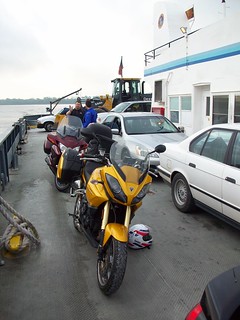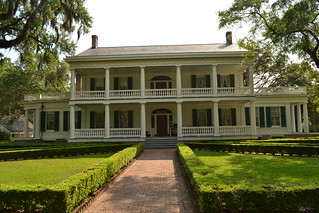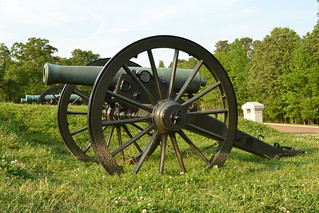Walking out of the Microtel Inn at 7:00 a.m., it was already 73 degrees and humid. This was going to be a hot day! Departing Breaux Bridge, we rode east on Interstate 10 a few miles until we entered a section of the Interstate designated the Atchafalaya Swamp Freeway. Spanning the Atchafalaya River Basin, the bridge is 18 miles long and is considered an engineering marvel. A few miles short of its eastern terminus, we exited the Interstate at exit 135 and proceeded north towards New Roads, Louisiana. We were on a schedule: there’s a Mississippi River ferry crossing that departs New Roads at 15 and 45 minutes past each hour. We were trying to hit the 8:15 a.m. boat. With about a minute to spare we rolled our bikes onto the steel deck of the ferry. Dropping the kickstands, we strolled the deck to talk with other passengers and take in the view during the ten minute complimentary river crossing.
The quaint, tidy town of Saint Francisville, Louisiana greeted us as we disembarked the ferry. Just a few miles out of town was the Rosedown Plantation State Historic Site. Built in 1835, at a cost of $13,100, the home anchored a 3,400 acre cotton plantation. At its height, the owners owned 450 slaves and produced 400 bales of cotton each year. Cotton production ceased in 1900, when the Boll Weevil made operations unprofitable. In the year 2000, the State of Louisiana acquired the main house, historic gardens, and 371 acres of original land. A $10 fee was paid for a self-guided walk of the gardens and a guided tour of the home. The gardens were extensive and beautiful but we had missed the azalea bloom by about three weeks. A line of massive oaks stand guard on either side of a long path leading to the main plantation home.
After the tour, we set back to Saint Francisville for lunch. This proved to be a bit more difficult then anticipated as most places were closed on Tuesday. Seeing a sign for the Saint Francisville Inn and Restaurant, we stopped for a visit. The building is better described as a cross between a motel / bed and breakfast than a restaurant. The main home had a small bar with over 40 different beers and 200 wines offered. We each selected a beer and then sat in a private courtyard surrounded by numerous rooms. The owner suggested we try the Magnolia Cafe for lunch. It was only a few hundred yards down the road and the food was reportedly good.
After the beer we rode the short distance to the cafe. Set back from the main road in a gravel parking lot, the building has a rustic appearance. We opted for seating on the screened-in porch and being my last opportunity to dine in Louisiana, I ordered a fried crawfish salad with an iced tea. The salad was excellent and well priced.
After lunch, we set off for Vicksburg, Mississippi, home to a long drawn out Civil War conflict that began in December 1862. After several failed attempts to take the city by force, Ulysses S. Grant decided to take Vicksburg by siege. This was made possible after Jackson, Mississippi fell to the Federals, cutting Confederate supply lines. After 47 days of siege, Vicksburg surrendered July 4, 1863, just one day after the battle at Gettysburg where Lee lost 1/3 of his army. While Gettysburg was the bloodiest battle of the Civil War, it was the fall of Vicksburg that signaled the end of any hope of victory for the Confederacy. Once Vicksburg was lost, the Mississippi River was in Federal hands – cutting off all Confederate lands west of the river. Though Vicksburg defined the beginning of the end for the South, the war would continue for an additional 21 months.
It was close to 5:00 p.m. when we checked into our underwhelming accommodation at the Roadway Inn. The rooms were a bit ragged, though the price was right at $50 for two and the location was pretty good. Thankful to be rid of our riding jackets on a sweltering afternoon, we set off for the Vicksburg National Military Park.
The park covers nearly three square miles of land. The park’s offices close at 5:00 p.m. but the gates remain open until 7:00 p.m. A 16 mile road weaves and wanders past 1,340 monuments, markers, and plaques commemorating and depicting the battles that took place 150 years ago. In a word, the park is overwhelming. The ravines, hills, and forest are plentiful and one can only imagine the difficulty it must have been fighting on such terrain. No wonder Grant resorted to siege. We had about an hour to ride the area before the gates closed. But one could easily spend an entire day. Students of the Civil War could spend weeks if not months studying here. And a motorcycle is not the best way to see the park. The stops are so frequent that dealing with a helmet is a hassle. Better is a guided tram tour. I’d suggest a bicycle, but you had best be in shape as some of the hills and ravines will give you a decent work-out. Most people we encountered were on foot: locals out for an evening walk or jog.
After the park, we stopped for dinner at Roca Restaurant and Bar in the Vicksburg Country Club. Service was prompt and courteous. I ordered an angle hair pasta and crab scampi. The meal was merely OK as the pasta was overcooked, the spices were bland and I needed a search party to find the alleged crab meat hidden in the dish.






